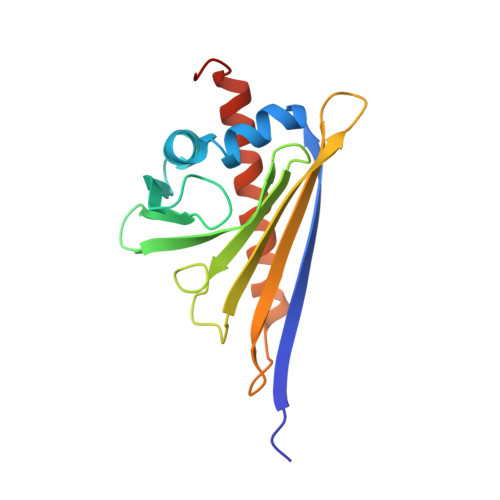Does the presence of ground state complex between a PR-10 protein and a sensitizer affect the mechanism of sensitized photo-oxidation?
Ignasiak-Kciuk, M., Nowicka-Bauer, K., Grzechowiak, M., Ravnsborg, T., Frackowiak, K., Jensen, O.N., Jaskolski, M., Marciniak, B.(2023) Free Radic Biol Med 198: 27-43
- PubMed: 36738800
- DOI: https://doi.org/10.1016/j.freeradbiomed.2023.01.022
- Primary Citation of Related Structures:
7QB6 - PubMed Abstract:
The mechanisms of one-electron protein oxidation are complicated and still not well-understood. In this work, we investigated the reaction of sensitized photo-oxidation using carboxybenzophenone (CB) as a sensitizer and a PR-10 protein (MtN13) as a quencher, which is intrinsically complicated due to the complex structure of the protein and multiple possibilities of CB attack. To predict and examine the possible reactions precisely, the 3D structure of the MtN13 protein was taken into account. Our crystallographic studies revealed a specific binding of the CB molecule in the protein's hydrophobic cavity, while mass spectrometry identified the amino acid residues (Met, Tyr, Asp and Phe) creating adducts with the sensitizer, thus indicating the sites of 3 CB* quenching. In addition, protein aggregation was also observed. The detailed mechanisms of CB quenching by the MtN13 molecule were elucidated by an analysis of transient products by means of time-resolved spectroscopy. The investigation of the transient and stable products formed during the protein photo-oxidation was based on the data obtained from HPLC-MS analysis of model compounds, single amino acids and dipeptides. Our proposed mechanisms of sensitized protein photo-oxidation emphasize the role of a ground state complex between the protein and the sensitizer and indicate several new and specific products arising as a result of one-electron oxidation. Based on the analysis of the transient and stable products, we have demonstrated the influence of neighboring groups, especially in the case of Tyr oxidation, where the tyrosyl radical can be formed via a direct electron transfer from Tyr to CB* or via an intramolecular electron transfer from Tyr to Met radical cation Met > S ● + or thiyl radical CysS ● from neighboring oxidized groups.
Organizational Affiliation:
Center for Advanced Technology, Adam Mickiewicz University, Poznan, Poland; Faculty of Chemistry, Adam Mickiewicz University, Poznan, Poland. Electronic address: [email protected].
















